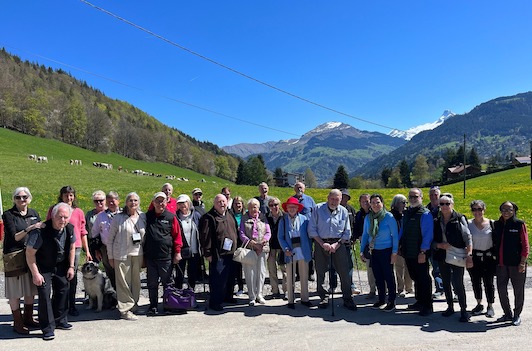A Yankee Notebook
NUMBER 2183
May 21, 2023
Down the Rhone to the Sea
EAST MONTPELIER, VT – On paper, the Connecticut River and the Rhone don’t look all that different. Each of them is about three hundred miles long from the town nearest its source (Pittsburg and Chamonix) to its debouchement into the sea (Long Island Sound and the Mediterranean). Their latitudes are only a couple of degrees apart. Each passes through progressively larger towns and cities and various styles of architecture (Avignon and Hanover; rustic to classical). Both have been the scenes of battles, massacres, and cultural disruption.
Gazing heavenward toward the looming snow and ice-clad Alps from any of the many plazas in Chamonix, however, is vastly different from looking upward toward the pine, spruce, and fir trees from in front of the general store in Pittsburg. You know you’re in a special place. The first winter Olympic games were held here, in 1924. The prevalence of chalet style is absolute, almost kitschy – sort of a European Lake Placid. But the mountains both overwhelm and justify it. In imagination, my eyes climbed castellated ridges and narrow couloirs toward towering, snowy peaks; my feet, steady beneath me (if I lean on my cane), have aged beyond yearning to be up there. The town and its mountains are spectacular enough.
Our first morning we all climbed aboard the electric-powered rack-and-rail tramway to an overlook and coffee shop high up in the valley of the Mer de Glace. We dined spectacularly that evening at a local restaurant and, still weary from our overnight flight from Boston, slipped early away to bed.
Our bus driver, a lovely young lady named Ombeline and soon to become like one of the group, had a serene air about her that, sitting right behind her, I found very comforting. During the next two days she took us on a tour to Annecy, the most spectacular town you never heard of, and Montelimar, the reputed nougat capital of the world. It was also the scene of a fierce battle in late August of 1944 when Allied tank and infantry units attacked retreating German forces, trying to block their escape from coastal France. We traveled down the same road that the Allies barricaded several times and between the hills where they positioned their artillery. We toured a nougat factory. I sat out front with a collection of ancient Renaults and Citroëns and chatted with a Dutchman on a huge BMW motorcycle who was reprising his father’s odyssey through France 55 years earlier.
That afternoon we met a cheerful young guide at the Palace of the Popes in Avignon. Life in Rome in the 14th century had become a little parlous for the popes, so the papacy decamped to some land it owned overlooking the only bridge over the Rhone and built a little country place, actually a gigantic fortified palace commanding the only bridge over the river. Some of our group knew the charming children’s round, “Sur le pont d’Avignon,” and regaled us with it. Some of us had beers while the others toured the palace.
(All the way from Chamonix to our last hotel in Aix-en-Provence I wrestled daily, gamely, and dangerously with the most outstanding triumph of French domestic design over common sense: the obscure and deadly shower control. It delivered blasts of water either icy or boiling for no apparent reason. I finally solved the problem by letting my companion take the first shower and asking her to leave it running.)
And so, finally, to Arles, the Rhone delta, and the Mediterranean Sea. At Cassis, a former fishing village and limestone quarry – limestone is everywhere! The water must be hard enough to cause a bruise – we dined al fresco in hazy sunshine that later removed a layer of skin, and took a boat ride along the coast (another layer of epidermis) to see the so-called “fjords of France.” Fjords they ain’t; fjords are formed by glaciers. But they are quite impressive: solution canyons (limestone again) indenting the cliffs of the south shore. Winston Churchill went there once in retirement to paint a view of the boldest headland. Here and there, rock climbers worked their way up the crags while their boats waited below.
Ombeline had become so much a part of us that we’d gladly have taken her home with us. But sadly, the morning after our farewell dinner and goofy awards ceremony, she dropped us off at the Marseilles airport (under construction, naturally). A long walk to the entrance dragging bags, and back to our old friend, British Airways, which had adjured us to show up three hours early in order to wait an hour for the agent to arrive. We were once again in the embrace of the civilized world. Our now-bonded family of thirty formerly disparate souls was about to be shattered and scattered. I hope that some of the friendships formed between Chamonix and Marseilles will continue – over delicate meals in French restaurants, perhaps.

Shot of our group on May 2023 tour of the Rhone Valley from Chamonix to Arles

